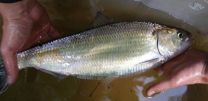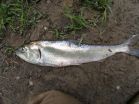(Press-News.org) Research from North Carolina State University finds that dam removal improves spawning grounds for American shad and seems likely to improve survival rates for adult fish, juveniles and eggs – but for different reasons.
The researchers focused on a small tributary in North Carolina called the Little River, where three dams were removed in the late 1990s and early 2000s. American shad (Alosa sapidissima) spend the bulk of their adult lives in saltwater, but return to freshwater rivers like this one to spawn. While in these freshwater environments, the adult shad do not feed. As a result, many of the adult fish die before they have a chance to return to the ocean.
Between 2008 and 2010, the research team tagged, weighed and released approximately 3,000 American shad at a weir – or fish gate – that was sited at one of the dam removal sites on the Little River. The shad were tagged on their way upstream to spawn. Researchers set up antennas along the length of the river to detect the fish tags, allowing the scientists to tell how far upstream the fish traveled.
"Shad were using all of the restored habitat," says Dr. Joshua Raabe, lead author of a paper on the research and an assistant professor at University of Wisconsin-Stevens Point who worked on the project while a Ph.D. student at NC State.
"This is important because upstream sites are generally higher-quality spawning sites, which should improve survival of eggs and juvenile fishes," says Dr. Joe Hightower, co-author of the paper and a U. S. Geological Survey scientist and professor of applied ecology at NC State. "For example, some key predator species, such as flathead catfish, become less common the further you go upstream."
The researchers also caught surviving shad on their way back downstream, allowing them to see how much weight the shad had lost while spawning and to estimate mortality rates. Mortality was high overall. Male shad could lose up to 30 percent of their body weight while spawning, while females could lose up to 50 percent.
The researchers found that weight loss was primarily linked to water temperatures and the amount of time the fish spent in the river, rather than how far upstream the fish went to spawn.
"This tells us that the longer fish are detained the more weight they'll lose, the more likely they are to die and the less likely they are to reach preferred habitat before spawning," Raabe says. "This is important information when considering waterways where dams or other obstacles could slow the shad's progress."
"Basically, the clock is ticking and these fish have a job to do," Hightower says. "The study indicates that anything we can do to improve fish passage should improve survival rates."
INFORMATION:
The paper, "American Shad Migratory Behavior, Weight Loss, Survival, and Abundance in a North Carolina River following Dam Removals," was published online May 13 in Transactions of the American Fisheries Society. Hightower is also part of the U.S. Geological Survey's North Carolina Cooperative Fish and Wildlife Research Unit based at NC State. The research was supported by the U.S. Fish and Wildlife Service.
Dam removal improves shad spawning grounds, may boost survival rate
2014-05-21
ELSE PRESS RELEASES FROM THIS DATE:
Breakthrough: Nasal spray may soon replace the pill
2014-05-21
Every time we have an infection or a headache and take a pill, we get a lot more drugs than our body actually needs. The reason is that only a fraction of the drugs in a pill reaches the right places in the body; the rest never reaches its destination and may cause unwelcome side effects before they are flushed out of the body again. This kind of major overdosing is especially true when doctors treat brain diseases, because the brain does not easily accept entering drugs.
"People with brain diseases are often given huge amounts of unnecessary drugs. During a long life, ...
Seeing is a matter of experience
2014-05-21
The headlights – two eyes, the radiator cowling – a smiling mouth: This is how our brain sometimes creates a face out of a car front. The same happens with other objects: in house facades, trees or stones – a "human face" can often be detected as well. Prof. Dr. Gyula Kovács from Friedrich Schiller University Jena (Germany) knows the reason why. "Faces are of tremendous importance for human beings," the neuroscientist explains. That's why in the course of the evolution our visual perception has specialized in the recognition of faces in particular. "This sometimes even ...
Cyberbullying affects rich and poor alike
2014-05-21
EAST LANSING, Mich. --- Cyberbullying isn't just a problem in middle class and affluent areas. Teenagers in poor, high-crime neighborhoods also experience online bullying, finds new research led by a Michigan State University criminologist.
The study suggests the "digital divide" – the gap between people with access to online technologies and those without – may be nonexistent, at least when it comes to cyberbullying, said Thomas J. Holt, MSU associate professor of criminal justice.
"We found neighborhood conditions that are indicative of poverty and crime are a significant ...
NASA sees developing tropical cyclone in Bay of Bengal
2014-05-21
VIDEO:
In this TRMM 3-D simulated flyby of System 92B from May 19, tall storms were shown reaching heights of over 14km (about 8.7 miles).
Click here for more information.
A tropical low pressure area known as System 92B has been organizing in the Northern Indian Ocean's Bay of Bengal and NASA's TRMM satellite has shown strong thunderstorms and heavy rainfall in the developing storm.
The Tropical Rainfall Measuring Mission or TRMM satellite passed over System 92B on May 19 and ...
Shared custody is becoming the norm
2014-05-21
It's no longer a certainty that American mothers will get custody over their children during a divorce. In fact, if Wisconsin Court Records of the past 20 years are anything to go by, joint custody is becoming the norm. So says Maria Cancian and colleagues from the University of Wisconsin–Madison in the US, whose findings are published in Springer's journal Demography.
For most of the twentieth century, in both divorce and nonmarital cases, most children ended up living with their mothers after their parents' divorce. This conformed to gender norms that views mothers ...
Functional nerve cells from skin cells
2014-05-21
A new method of generating mature nerve cells from skin cells could greatly enhance understanding of neurodegenerative diseases, and could accelerate the development of new drugs and stem cell-based regenerative medicine.
The nerve cells generated by this new method show the same functional characteristics as the mature cells found in the body, making them much better models for the study of age-related diseases such as Parkinson's and Alzheimer's, and for the testing of new drugs.
Eventually, the technique could also be used to generate mature nerve cells for transplantation ...
Low IQ students learn to read at 1st-grade level after persistent, intensive instruction
2014-05-21
VIDEO:
Children identified as intellectually disabled or with low IQ learned to read at a first-grade level after persistent, intensive instruction from a scientifically based curriculum. The findings of the pioneering...
Click here for more information.
The findings of a pioneering four-year educational study offer hope for thousands of children identified with intellectual disability or low IQ who have very little, if any, reading ability.
The study by researchers at Southern ...
On the road to improvement: EPA's troubled program on chemical hazards
2014-05-21
Out of the thousands of chemicals used for countless everyday products, about 500 have been assessed for potential health risks by the federal program tasked with this colossal duty. The good news is the Environmental Protection Agency, which runs the program, has improved it, but more remains to be done, according to a report from the National Research Council (NRC). Chemical & Engineering News (C&EN), the weekly news magazine of the American Chemical Society, hits the report's highlights.
Cheryl Hogue, senior correspondent for C&EN, explains that the EPA program, called ...
A new solution for storing hydrogen fuel for alternative energy
2014-05-21
Turning the "hydrogen economy" concept into a reality, even on a small scale, has been a bumpy road, but scientists are developing a novel way to store hydrogen to smooth out the long-awaited transition away from fossil fuels. Their report on a new solid, stable material that can pack in a large amount of hydrogen that can be used as a fuel appears in the ACS journal Chemistry of Materials.
Umit B. Demirci and colleagues explain that storing hydrogen in solids is a recent development and a promising step toward building a hydrogen economy. That's the idea originated ...
Paper-based diagnostics, made with a scrapbooking tool, could curb hepatitis C pandemic
2014-05-21
To the relief of patients diagnosed with hepatitis C, the U.S. Food and Drug Administration approved two new treatments late last year, and a few more are on the way. Now scientists are solving another side of the disease's problem: identifying the millions more who have the virus but don't know it — and unwittingly pass it on. A report in the ACS journal Analytical Chemistry describes a novel, scrapbook-inspired test that does just that.
Xuan Mu, Zhi Zheng and colleagues point out that the hepatitis C virus (HCV), a blood-borne pathogen that can cause liver cirrhosis, ...






